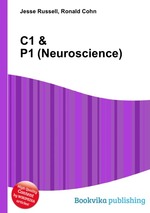C1 & P1 (Neuroscience)
Jesse Russell Ronald Cohn
бумажная книга
High Quality Content by WIKIPEDIA articles! The C1 and P1 (also called the P100) are two human scalp-recorded event-related brain potential (ERP) components, collected by means of a technique called electroencephalography (EEG). The C1 is named so because it was the first component in a series of components found to respond to visual stimuli when it was first discovered. It can be a negative-going component (when using a mastoid reference point) or a positive going component with its peak normally observed in the 65-90ms range post-stimulus onset. The P1 is called the P1 because it is the first positive going component (when also using a mastoid reference point) and its peak is normally observed in around 100ms. Both components are related to processing of visual stimuli and are under the category of potentials called visually evoked potentials (VEPs). Both components are theorized to be evoked within the visual cortices of the brain with C1 being linked to the primary visual cortex (striate cortex) of the human brain and the P1 being linked to other visual areas (Extrastriate cortex). One of the primary distinctions between these two components is that, whereas the P1 can be modulated by attention, the C1 has been typically found to be invariable to different levels of attention.


